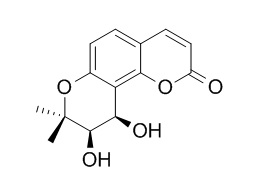Khellactone
Khellactone shows antitumor activity,it can suppress the growth of NCI-H460 tumor cells. (+)-4'-cis-Khellactone and (+)-3'-cis-khellactone have antiplasmodial activities, they show notable inhibitory activity against -sensitive strains of with IC(50) values from 1.5 and 2.4 microM.
Inquire / Order:
manager@chemfaces.com
Technical Inquiries:
service@chemfaces.com
Tel:
+86-27-84237783
Fax:
+86-27-84254680
Address:
1 Building, No. 83, CheCheng Rd., Wuhan Economic and Technological Development Zone, Wuhan, Hubei 430056, PRC
Providing storage is as stated on the product vial and the vial is kept tightly sealed, the product can be stored for up to
24 months(2-8C).
Wherever possible, you should prepare and use solutions on the same day. However, if you need to make up stock solutions in advance, we recommend that you store the solution as aliquots in tightly sealed vials at -20C. Generally, these will be useable for up to two weeks. Before use, and prior to opening the vial we recommend that you allow your product to equilibrate to room temperature for at least 1 hour.
Need more advice on solubility, usage and handling? Please email to: service@chemfaces.com
The packaging of the product may have turned upside down during transportation, resulting in the natural compounds adhering to the neck or cap of the vial. take the vial out of its packaging and gently shake to let the compounds fall to the bottom of the vial. for liquid products, centrifuge at 200-500 RPM to gather the liquid at the bottom of the vial. try to avoid loss or contamination during handling.
J Food Sci.2021, 86(9):3810-3823.
J Med Food.2021, 24(2):151-160.
Food Funct.2024, 15(8):4262-4275.
Chengdu University of Traditional Chinese Medicine2024, 4802935.
Separations2021, 8(1), 1.
Korean Journal of Pharmacognosy2014, 113-120
Antioxidants (Basel).2020, 9(2):E120
Inflammation2015, 38(1):445-55
Nutrients.2024, 16(22):3805.
Neuroscience.2024, 559:77-90.
Related and Featured Products
Phytother Res. 2010 Mar;24(3):469-71.
Antiplasmodial and cytotoxic activity of khellactone derivatives from Angelica purpuraefolia Chung.[Pubmed:
19960419 ]
The methanolic extract of the rhizomes parts of Agelica purpuraefolia was investigated for its activity against chloroquine-sensitive strains of Plasmodium falciparum using the parasite lactate dehydrogenase assay method.
METHODS AND RESULTS:
Two natural Khellactone, (+)-4'-Decanoyl-cis-Khellactone (1) and (+)-3'-Decanoyl-cis-Khellactone (2) were isolated from the rhizomes parts of A. purpuraefolia. Two compounds were evaluated for in vitro antiplasmodial activities as well as their cytotoxic potential on SK-OV-3 cancer cell line cells. Compounds 1, 2 showed notable growth inhibitory activity against chloroquine-sensitive strains of Plasmodium falciparum with IC(50) values from 1.5 and 2.4 microM. This compound showed no significant cytotoxicity (IC(50) > 100 microM) evaluated using SK-OV-3 cancer cell line cells.
CONCLUSIONS:
This is the first report on the antiplasmodial activity of the compounds from A. purpuraefolia.
Phytother Res. 2007 May;21(5):406-9.
Isolation of coumarins and ferulate from the roots of Angelica purpuraefolia and the antitumor activity of khellactone.[Pubmed:
17236175 ]
A new coumarin, hydroxylomatin (1), was isolated from the CHCl(3)-soluble fraction of the roots of Angelica purpuraefolia, along with one ferulate (2) and three other known coumarins (3-5) including Khellactone (3). The structure of hydroxylomatin (1) was determined to be 3'beta,5'-dihydroxy-3',4'-dihydroseselin (1) by spectroscopic means including 2D-NMR. The modified Mosher's method was used to determine the chiral center at C-1 of compound 2. Khellactone (3) is a major compound of the roots of A. purpuraefolia.
METHODS AND RESULTS:
This study also examined the antitumor activity of Khellactone (3) using a LLC mouse lung carcinoma in the BDF-1 mice and a NCI-H460 human lung carcinoma in a human tumor xenograft model in nude mice. This compound (3) inhibited LLC tumor growth with a T/C (mean value of treated group/mean value of control group) value of 12.9% at a dose of 5 mg/kg and 33.2% at a dose of 10 mg/kg, respectively, in a dose-dependent manner. In addition, it suppressed the growth of NCI-H460 tumor cells, accounting for 81.4% at a dose of 10 mg/kg in nude mice.



